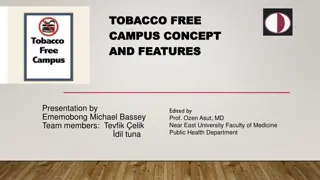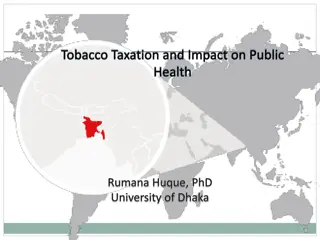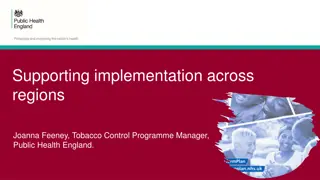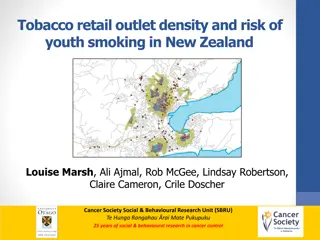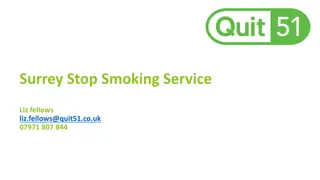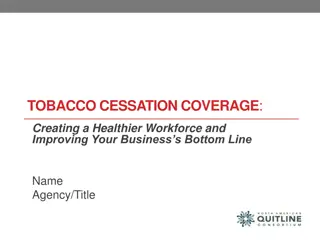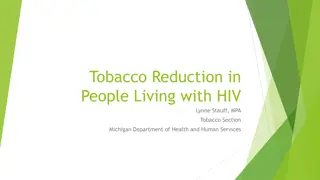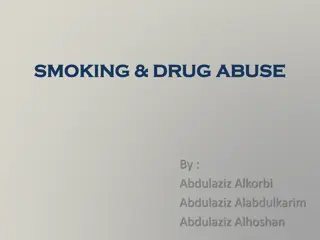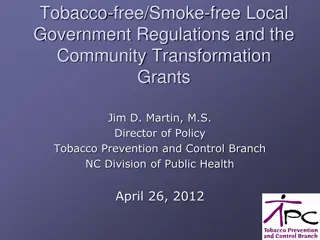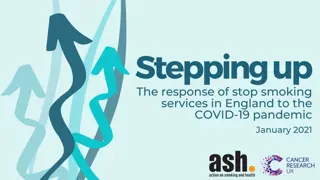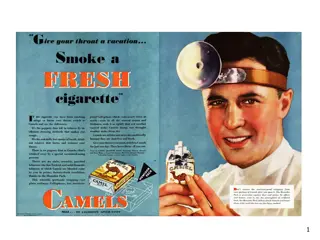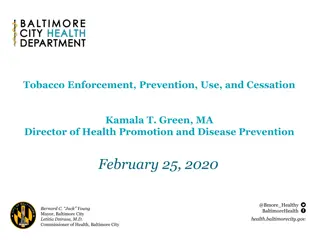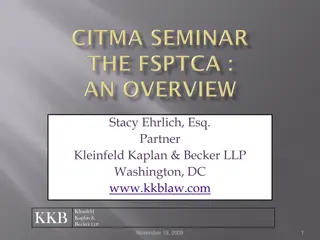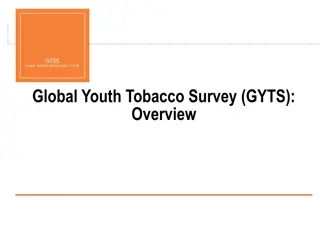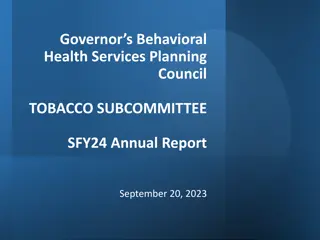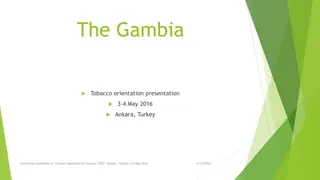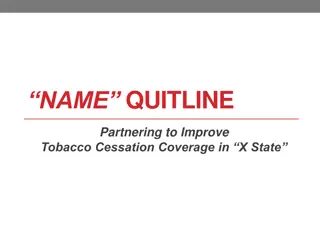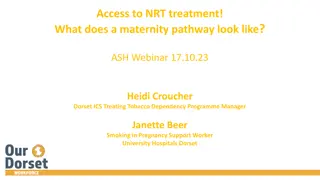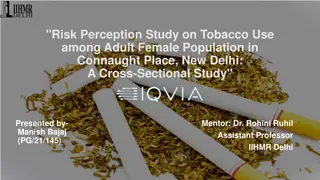Local Authority Stop Smoking Services and Wider Tobacco Control in England, 2023
The report presents key findings from the 10th annual survey of tobacco control leads in English local authorities, highlighting the significant focus on tobacco control, efforts to tackle inequalities, support for smokers to quit, diverse activities undertaken, and the importance of relationships with the NHS. Tobacco control is identified as a high priority, with strategies in place to reduce smoking prevalence and promote smoke-free environments.
Download Presentation

Please find below an Image/Link to download the presentation.
The content on the website is provided AS IS for your information and personal use only. It may not be sold, licensed, or shared on other websites without obtaining consent from the author.If you encounter any issues during the download, it is possible that the publisher has removed the file from their server.
You are allowed to download the files provided on this website for personal or commercial use, subject to the condition that they are used lawfully. All files are the property of their respective owners.
The content on the website is provided AS IS for your information and personal use only. It may not be sold, licensed, or shared on other websites without obtaining consent from the author.
E N D
Presentation Transcript
Local authority stop smoking services and wider tobacco control in England, 2023
The full report can be accessed online If you have any questions, please get in touch by emailing admin@smokefreeaction.org.uk
Background The report, written by ASH and funded by Cancer Research UK, presents findings from the 10th annual survey of tobacco control leads in English local authorities, tracking activity since public health was transferred to local government. We heard from 116 individuals covering 124 (83%) of the 150 local authorities in England with public health responsibility. The survey closed in September 2023, prior to the announcement in October 2023 of the smokefree generation proposal and increased funding for local authorities.
Key findings Tobacco control is a the highest priority for local government in 10 years Tackling inequalities is central to the tobacco control work of local authorities Almost all local authorities continue to provide support to help smokers quit Local authorities are pursuing a diverse range of activity on tobacco Relationships between local government and the NHS are growing in importance Not all councils currently have policies in place to protect council from industry influence
Priority given to tobacco control Perceived priority of six public health issues within surveyed local authorities Tobacco control was perceived to be a high priority in 43 surveyed local authorities (37%) and a low or below average priority in 9 (8%). Higher than at any point in the last decade. drugs 46% 36% 18% tobacco 37% 26% 29% 7% 1% alcohol 33% 36% 27% 4% overweight 32% 29% 31% 6% 2% Tobacco was more often perceived to be a high priority than alcohol, overweight, sexual health and gambling. A high priority for drugs was perceived more often than a high priority for tobacco. sexual health 31% 30% 34% 5% gambling 6% 10% 35% 31% 19% High Above average Average Below average Low
Comprehensive tobacco control 68% of local authorities had a current strategy for tobacco control and stop smoking services: Key goals of these strategies were to reduce smoking prevalence, reduce smoking-related inequalities, promote smokefree environments, and reduce the trade in illicit tobacco and vaping products. 60% of local authorities had a tobacco control alliance at the time of the survey, up from 54% in 2021. Local authorities that had a tobacco control alliance were far more likely to have a tobacco control strategy (83% did so) than local authorities that did not have an alliance (27%).
Regional variation in strategy, partnership, leadership 300% 250% 70% 50% 200% 77% 69% 63% 78% 63% 150% 88% 60% 100% 43% 71% 69% 72% 100% 58% 60% 67% 53% 44% 25% 50% 100% 90% 86% 85% 68% 67% 60% 56% 56% 46% 0% Has a strategy for tobacco control Has a tobacco control alliance High/above average priority for tobacco control
Inequalities 94% of local authorities described their approaches to tackling smoking-related inequalities. Approaches included: Gaining intelligence to understand the profile of local needs and inequalities Strategic planning with local partners KPIs or targets for tobacco control which were differentiated by priority populations Targeting of stop smoking services. A variety of approaches to targeting including area-based clinics, integration with other high-need services, workplace support, specialist advisers, the use of incentives, and outreach into communities. An accessible, flexible and adaptable universal service is itself integral to the task of reducing inequalities. Most local authorities did not limit their stop smoking services to target populations but integrated targeted approaches with a universal service. Tackling the illicit trade was identified by some as a key component of local and regional efforts to reduce smoking-related inequalities.
Inequalities Populations targeted for stop smoking support by local authorities in England, 2023 Population Local authorities (n=120) 77 (64%) 74 (62%) 73 (61%) 58 (48%) 40 (33%) There is a wide range of populations where LA are taking a targeted approach This diversity may mean that some groups are being systematically underserved. For example smokers in social housing make up a quarter to a third of all smokers but are only targeted in 12% of LA People with mental health conditions Pregnant women People in routine or manual occupations Areas of high deprivation People with COPD, CVD, cancer or other long-term conditions Young people Black and minority ethnic populations People with alcohol or drug use problems LGBTQ+ community Partners or household members of pregnant women People living in social housing Homeless people Parents with young children People who are unemployed People with learning disabilities People with complex health needs People on low incomes Refugees/asylum seekers 26 (22%) 25 (21%) 25 (21%) 16 (13%) 16 (13%) 14 (12%) 12 (10%) 8 (7%) 8 (7%) 7 (6%) 5 (4%) 4 (3%) 3 (3%)
Stop smoking services: provision Mix of services commissioned or provided for smokers by local authorities in England, 2023 Principal offer to smokers (exclusive categories) local authoriti es (n=123) Additional services commissioned (% of this principal commissioned service) Integrate d lifestyle service 25 (32%) 45 (58%) All but two local authorities commissioned or provided stop smoking services. Specialist stop smoking services were commissioned by 72% of local authorities. This includes 63% of local authorities that delivered a universal service. Primar y care Other provide r Most services offer a mix of support types Specialist stop smoking service (universal) Specialist stop smoking service (targeted) Integrated lifestyle service Support from primary care 78 (63%) 38 (49%) Methods used to provide stop smoking support in services commissioned by local authorities, 2021-2023 11 (9%) 2 (18%) 2 (18%) 1 (9%) Method Local authorities 2023 (n=123) 116 (94%) 115 (94%) 76 (62%) 54 (44%) 50 (41%) 42 (34%) 2022 (n=127) 96% 95% 63% 39% 51% 24% 2021 (n=150) 98% 83% 75% 47% 60% 40% 23 (19%) 13 (57%) 9 (39%) Telephone advice Face-to-face advice Text messaging Email Video conferencing Mobile phone apps 9 (2%) 6 (67%) No service 2 (2%)
Regional variation in types of support Has a universal specialist stop smoking service 90% 82% 79% 78% 80% 69% 70% 63% 63% 60% 60% 60% 50% 50% 40% 33% 30% 20% 10% 0%
Stop smoking services: Changes in demand Change in demand for local authority stop smoking services, 2023 Demand for stop smoking services had increased in 36% of local authorities and decreased in 18%. Don't know, 8% Decrease, 18% Increase, 36% The principal driver of increased demand was the introduction of targeted lung health checks and tobacco dependence treatment services in the NHS. No-one reported a fall in demand due to the NHS taking over responsibility for stop smoking support in maternity, acute and mental health settings. No change, 39%
Stop smoking services: medications, vapes and incentives Dual-form NRT was offered to smokers by 114 local authority stop smoking services (93% of all surveyed local authorities). In two thirds of surveyed local authorities (83, 67%) e-cigarettes or vapes were offered to some or all smokers using stop smoking services. 27% of local authorities offered incentive schemes for pregnant women. Offers e-cigarettes to smokers 90% 75%77%80% 80% 80% 64% 64%67% 67% 67% 70% 60% 47% 50% 40% 30% 20% 10% 0%
Tobacco control activity Enforcement and illicit trade: 89% of local authorities reported conducting underage test purchases of tobacco products or vapes and/or seizing illicit tobacco products or vapes in the 12 months prior to the survey. Smokefree environments: 57% of local authorities had undertaken work in the 12 months prior to the survey to promote smokefree environments including 24% that had supported the creation of new smokefree public spaces and 46% that had undertaken work to promote smokefree homes. Children and young people: 79% of local authorities had done work in the previous 12 months to prevent children and young people smoking tobacco products, and 91% had done work to prevent children and young people vaping. Public communication campaigns: 79% of local authorities had run public communication campaigns about smoking and 46% had run public communication campaigns about vaping.
Relationship with the NHS Involvement of local authorities in the planning and delivery of NHS tobacco dependence treatment services The level of local authority involvement in the planning and delivery of NHS Long Term Plan services varied widely. Although 95% of surveyed local authorities had been involved in some way in this major programme of new work, the level of involvement ranged from taking a lead in delivering NHS tobacco dependence treatment services (16%) to simply being consulted (32%). LA is not involved, 5% LA leads the work, 16% LA is consulted, 32% LA is an equal partner with the NHS, 26% LA is a junior partner with the NHS, 21%
Relationship with the NHS With increased NHS activity respondents were concerned about the potential increase in referrals [they had no extra funding at this point], the inadequacy of patient pathways and referral protocols, and the impact of the anticipated loss of the ring fence on the sustainability of tobacco dependence treatment services. However, these new NHS services were also recognised to be an opportunity to reach more smokers and develop an integrated approach across the NHS and community stop smoking services. Survey respondents were asked to describe any ways in which their stop smoking services had been reconfigured in response to the introduction of tobacco dependence treatment services and/or targeted lung health checks. They described: ensuring that support was available to patients discharged from NHS services and that referrals were appropriate working closely with NHS partners to maximise outcomes from the combined services rethinking priorities for the community service
Protecting councils from industry influence Local authorities with policies restricting engagement of members and officers with industry Survey respondents were asked if there were any policies in their local authorities restricting the engagement of their officers or members with representatives of the tobacco, alcohol and food industries. Tobacco industry 50% 11% 39% Alcohol Industry 16% 11% 73% Although policies restricting engagement with the tobacco industry were reported in 50% of local authorities, respondents did not know if such policies existed 39% of surveyed local authorities and did not have a policy in 11%. Food industry 9% 10% 81% Yes No don't know
Changes over the decade: strategy The proportion of local authorities where tobacco control is perceived to be a high priority is now (37%) more than double the level in 2014 (17%). In 2014, 69% of surveyed local authorities had a tobacco control plan, likewise in 2023, 69% of surveyed local authorities had either a tobacco control strategy or a broader strategy which included tobacco control. Targets have shifted from being principally set in terms of the number of four-week quitters in 2015, to today where smoking prevalence targets are more common. The national smokefree target for 2030 has contributed to this shift. The number of surveyed local authorities with a tobacco control alliance (60%) has risen from 54% in 2021 but remains lower than 73% in 2014. In 2015, 71% of surveyed local authorities were working with other councils to deliver tobacco control or smoking cessation interventions. Now 78% of local authorities are involved in regional or supra-local tobacco control work.
Changes over the decade: services Between 2016 and 2018 the proportion of surveyed local authorities with a specialist stop smoking service fell from 75% to 65%, this increased to 72% in 2023. There s been a shift towards commissioning integrated lifestyle services as an alternative or complement to specialist stop smoking services. Little change over time in the number of local authorities offering dual NRT. In 2018, 89% of surveyed local authorities offered these medications, rising to 93% in 2023. Use of e-cigarettes as a treatment option has risen from 11% in 2019 to 67% in 2023. In 2018, 93% of local authorities offered Champix to clients of their stop smoking services. Now, following the withdrawal of Champix from the market in 2021, only 4% offer generic varenicline. Between 2016 and 2023 pregnant women changed from the most to second most commonly identified target group. This is likely to reflect the ongoing transfer of responsibility for providing stop smoking support to pregnant women from local authority services to NHS tobacco dependence treatment services.
Changes over the decade: wider activities Since the survey recorded the range of wider tobacco control work in 2019, tackling illegal tobacco has consistently been the most frequently reported among surveyed local authorities. In 2023, 46% of local authorities undertaking work to promote smokefree homes is a similar result to the last 5 years The ASH/CRUK survey has consistently found high levels of commitment to public communication and campaigns. In both 2015 and 2019, opportunities most often identified for tobacco control include joint working, partnerships and alliances, similarly in both years the most common threat was pressure on budgets.
Key insights This report describes a remarkable range of tobacco control work currently being pursued by local authorities through strong partnerships across health economies and local communities: councils are well placed to accelerate activity with new funding awarded since this survey closed. The most ambitious local authorities are moving on many fronts: tackling the illicit trade in tobacco and vapes; promoting smokefree public spaces, workplaces and homes; running campaigns about smoking and vaping; and providing specialist support to smokers to help them quit. This comprehensive approach, however, is not universal and too many areas lack a strategy or tobacco alliance to drive forward activity. The focus on inequalities in most LA is right. BUT there is a lot of diversity in target populations with some important groups not prioritised.
Key insights The increase in government support for stop smoking services and tobacco control is timely. The expansion of tobacco dependence treatment services and targeted lung health checks in the NHS is putting pressure on community stop smoking services. With adequate resources, there is an opportunity for local authorities to work with the NHS and other community partners to build more integrated approaches to tobacco control and stop smoking services that have the potential to reach many more smokers. In another ten years, it is unlikely that smoking will have become entirely a thing of the past, but the health of all affected communities will hopefully have been transformed.
The full report can be accessed online If you have any questions, please get in touch by emailing admin@smokefreeaction.org.uk



